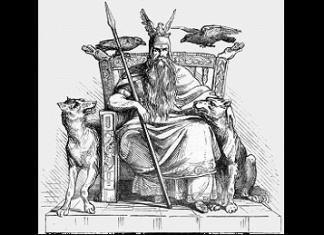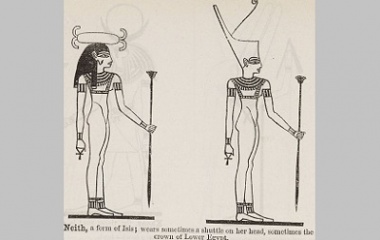- Pronunciation: nay-th
- Origin: Egypt
- Cult Center: Sais
- Role: Creator, warrior, hunter, weaver
- Symbols: Shield, crossed arrows, weaving shuttle, red crown
- Children: Ra, Apep, Sobek
Who Is Neith?
Warrior goddess Neith is considered the mother of all the gods. She was a creator of the world and the mother of the very influential sun god Ra, who finished the creation after his birth. As a creator, Neith was an early goddess in the Egyptian pantheon and the people worshipped her throughout Egypt. In later years, Neith was mainly recognized in the Western Nile Delta at her cult center of Sais.
Known as a huntress during the pre-dynasty time period, her symbol was a shield crossed with arrows. The other symbol of Neith is a weaving shuttle. She was also considered the goddess of weaving. Frivolous as this may seem for a goddess, there is a myth that suggests Neith created the world by weaving it.
Neith was the patron goddess of the Red Crown of Lower Egypt, and was often portrayed wearing her Red Crown. However, in the creator stories inscribed in ancient hieroglyphics, she is also portrayed with an ejaculating phallus. Although known as goddess, Neith was actually androgynous, at least in terms of her role in creation.
Origin
As one of the eldest goddesses, Neith emerged from the primeval waters to create the world. As time went on and myths evolved, Neith took on other characteristics and responsibilities. Although originally a hunter and warrior, and always considered a great protector of the Egyptian people, she was also a wise mediator between gods, as well as between humanity and the gods. In addition, Neith cared for the dead and helped to dress their souls in preparation for the afterlife.
Neith had no known husband, so was designated a “Virgin Mother Goddess”. The phallic symbolism in the hieroglyphics surrounding her is a nod to the masculine energy also required in the creation of the universe.
Family of Neith
Neith is the mother of the sun god Ra, which is her connection to the god Nun, his father. Nun represented the waters of chaos out of which their god child Ra was born. When Neith spat in the waters of Nun, the serpent Apep was created and deemed “the Lord of Chaos”. The evil snake brother was the enemy of Ra.
Since the goddess is associated with water, Neith is also believed to be the mother of Sobek, the fierce crocodile god and ruler of the Nile.
Influence
As an elder goddess, Neith was often called upon to settle the disputes of other gods. After completing his mother’s work of creating the world, Ra became the king. The rule of the kingdom later passed to Shu, the air god, and then to his son Geb, the earth god, and finally to his son Osiris, who was married to his own sister, the queen Isis. The reign of Osiris and Isis was a time of peace and prosperity and is referred to as the Golden Age. This earned Osiris great favor with the other gods.
Seth, the brother of Osiris, was jealous of his sibling’s success and wanted the throne for himself. He murdered the king and cut his body into pieces, which he then scattered all over Egypt. Then he installed himself as the new king, and anointed his sister Nephthys as queen.
Heartbroken, Isis journeyed the land and collected all the parts of her husband’s body. She put him back together and enlisted the help of the sun god Ra to bring him back to life by tricking him into telling her his secret name. When the name was spoken, it could revive the dead.
Isis was able to revive Osiris long enough for their son to be conceived, ensuring a rightful heir to the throne. Afterward, Osiris descended to the underworld, and became the ruler there.
The Contest of Horus and Seth
Horus, the son of Isis and Osiris was born. Isis hid the child because she feared that Seth would kill him to avoid any challenge for the throne. Horus grew up to be a strong young man and set out to claim his rightful kingship.
Horus went to the assembly of the gods, led by Ra, and presented his argument that he was the rightful king as the son of Osiris. Seth, of course, adamantly opposed this notion. Ra felt that Horus was too young and lacked experience; however, the other gods debated the merits of the two and favored Horus. In the end, they were undecided.
As she was known for her wisdom, the council of gods called upon Neith to resolve the matter. Neith decided that Horus should be king, but as compensation Seth would be awarded two new wives. These wives were Anat and Astarte, the daughters of Ra.
The council reconvened and Seth and Horus continued to present their arguments for the throne. There were several incredible contests of strength and intelligence between the two, and some tricky intervention by Isis. In the end, Horus prevailed and Seth begrudgingly conceded the throne. In addition to receiving two new wives, Seth was appointed to the coveted position of guardian and master of the boat of Ra. Together, they traveled the sky by day and the underworld after dark.
The reign of Horus was a time of peace and prosperity.
Modern Influence
Theorists offer the possibility that the myths of the goddess Neith may have had an influence on both the Old and New Testament. The book of Genesis reveals that god effected creation by bringing light to the dark waters, which is very similar to the creation story of Neith. Neith was the “Virgin Mother Goddess” that predated Mary, the virgin mother of Jesus.










